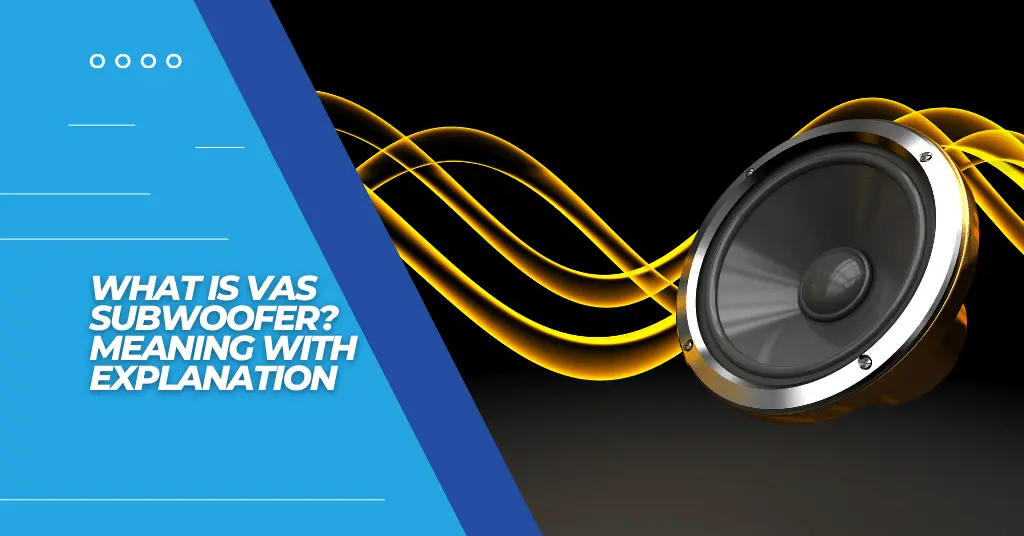What Is VAS Subwoofer?

A subwoofer is a nice idea to enhance the music experience. However, do you know how does a subwoofer work? There is a lot of effort & physics put behind developing the sub and its enclosure.
You must’ve heard about the VAS, and that’s why you are here. A VAS (Volume of Air Suspension) plays a significant role in order to get deep bass out of the subwoofer. It’s not rocket science to understand the term.
However, you should carefully read the article till the end if you are a new engineer or a person who is going to make their first subwoofer enclosure. Let’s begin!
What Does VAS Stand For in a Subwoofer?
Many experts have given different names to VAS in subwoofers. For me, I would just say “Volume of Air Suspension.” However, you may also use the term “Equivalent Compliance Volume.” In the audio world, especially the subwoofer technology, VAS is defined as a critical parameter that characterizes a subwoofer’s mechanical behavior. It tells you the volume of air (when compressed) that compliance (springiness) as the speaker’s suspension system.
In easy words, it’s a measure of the speaker cone’s freedom to move in response to a change in air pressure. Your question doesn’t here! Please read forward to know the “Importance of VAS.”
What Are the Effects of VAS on a Subwoofer?
According to my deep observations, you may find these changes if you play with VAS:
1. Bass Extension and Depth:
It’s not surprising if I say this parameter affects not only a subwoofer’s bass depth but also its extension, i.e., its ability to accurately reproduce the lowest frequencies (resonant frequency).
For example, if you play a subwoofer with a higher VAS, it will reproduce these low frequencies more effectively, leading to a richer, fuller bass sound. However, there is one trade-off here!
A subwoofer with extensive VAS requires a bigger enclosure to function optimally, making it bulky and less suitable for smaller spaces.
2. Enclosure Size and Type:
Let me explain the enclosure part a bit more! As I said, a higher VAS subwoofer requires a larger enclosure to maximize the subwoofer’s efficiency. But it also has some effects on the enclosure type.
For example, VAS works well with ported or bandpass designs rather than sealed enclosure or tube designs. That’s the reason why so many experts recommend ported boxes to achieve deep bass in a car or home theater system.
On the other hand, if you have a low VAS value sub & looking for tight bass, you can go with smaller, sealed boxes, as it has lower compliance and requires less air volume for optimal performance.
3. Transients and Control:
You may also notice differences in transient response and control of a loudspeaker with the changes in VAS value. An excessively high Vas value may result in a delayed and overextended transient response, resulting in less precise audio output.
While a lower Vas value can deliver tighter control over the speaker’s movement, leading to a more accurate and faster transient response.
Therefore, engineers often optimize VAS in conjunction with other parameters to achieve a harmonious balance between deep bass and tight control.
4. Amplifier Matching:
Yes! You read it right! It doesn’t only affect the subwoofer, bass, or enclosure but also the external component, such as the amplifier.
How? As it directly influences the optimum enclosure type and size for the subwoofer, the changes in both parameters will affect the amplifier’s performance.
If the amplifier doesn’t match the VAS value, it may overdrive the subwoofer, causing distortion or even equipment damage. Also, an underpowered amplifier may not fully utilize the subwoofer’s potential.
Therefore, you should also have to make a perfect match between the VAS & amplifier to get the most out of your sound system.
5. Room Acoustics:
If someone asks me about choosing the right subwoofer according to their room or car size, I also consider VAS as one of the major requirements to meet the desired results.
For example, subwoofers with high VAS values and the same stiffness perform optimally in larger rooms to effectively generate waves that fill the space.
On the other side, a low VAS suggests a stiffer cone, which can limit bass buildup in smaller rooms, preventing the sound from becoming too overpowering.
How Do You Calculate the Right VAS for a Subwoofer?
There are online tools available that will do the challenging maths for you in order to decide the correct VAS requirement. But if you want to do it yourself, here is my step-by-step guide:
1. Gather Mechanical Parameters:
To start the VAS calculation, you must determine some essential mechanical parameters of the subwoofer. These parameters are easy-to-evaluate and are listed below:
- Sd (Surface Area of Cone): The area covered by the subwoofer’s cone.
- Cms (Mechanical Compliance of Speaker Suspension): The subwoofer’s suspension system compliance.
- ρ (Air Density): The density of the surrounding air.
- π (Pi): A mathematical constant (approximately 3.14159).
2. Understand the Equation:
After determining the required mechanical parameters of the subwoofer, you’ll have to familiarize yourself with the below formula:
VAS = (Cms / ρ) Sd^2 / (4 π^2)
Let me breakdown the equation for yourself:
- VAS: As mentioned above, It is the “Equivalent Compliance Volume,” which signifies the air volume that the subwoofer’s suspension system behaves similarly to when it’s compressed.
- CMS: It stands for “Mechanical Compliance of Suspension.” This value defines the flexibility or compliance of the subwoofer’s suspension, measuring how easily it (voice coil) can move back and forth. It is expressed in meters per newton (m/N).
- ρ (Rho): This value stands for “Air Density” in the above formula. This tells you the air mass per unit box volume. However, in physics, it is measured in kilograms per cubic meter (kg/m³).
- Sd: It stands for “Surface Area of Cone.” This measures the area covered by the subwoofer’s cone, measured in square meters (m²).
- π (Pi): Well! We all know about it. A mathematical constant approximately equal to 3.14159 is commonly used in geometric calculations.
3. Apply the Equation:
Get all the required values from your subwoofer and plug them into the above equation. Please be confident enough to provide the correct values; otherwise, the result will be wrong, and you will most likely make the subwoofer enclosure the wrong way.
Anyway, the resulting Vas value will be in cubic meters (m³), so you may need to convert it to liters (L) for practical use.
4. Interpretation and Adjustment (What Else You Need to Do):
Once you have determined the VAS value, your work doesn’t stop here! You would have to interpret it with other required values in order to get your dream subwoofer design & system requirements. What else do you need to consider? You can have a look below:
- Enclosure Type: You should go with ported enclosures after getting the high VAS value. According to my experience, a VAS value of around 250 to 300 liters (L) [0.25 cubic meters (m³) to 0.3 cubic meters (m³)] or higher is often considered high for ported enclosure design subwoofers. A subwoofer with below this value can go with a small or sealed box.
- Room Size: Someone with a room space of at least 200 to 300 square feet or more can go with a high VAS subwoofer. In this way, he can fill up his larger room with the deep bass.
- Sound Signature: You should also determine what type of listener you are! Choose a subwoofer with high VAS value if you are a deep and impactful bass lover. On the other hand, you can go with a smaller subwoofer if you like tight bass.
- Amplifier Matching: You should also ensure the calculated VAS value aligns with the power capabilities of the amplifier you plan to use.
General FAQs
What Is the Relationship Between VAS and Subwoofer Box Size?
It’s a key parameter in determining the optimal box size for a subwoofer. Generally, a larger VAS means the subwoofer requires a larger enclosure to resonate effectively.
How Does VAS Affect the Overall Sound Signature of a Subwoofer?
It essentially represents the air volume with the exact acoustic compliance as the driver’s suspension. A larger VAS indicates a looser suspension, leading to a more boomy or resonant bass response, while a smaller Vas suggests a tighter, more controlled bass sound (resonant frequency).
Can a Subwoofer With a High VAS Value Be Used in a Small Room?
Yes, a high VAS-valued subwoofer can be used in a small room. However, it requires a larger enclosure for optimal performance, which might not be ideal for small spaces. You can also make some adjustments in the design to compensate, but this may influence the subwoofer’s overall output.
Can I Pair Multiple Subwoofers With Varying Vas Values in the Same System?
Yes, you can pair multiple subwoofers with varying VAS values in the same system. However, it’s essential to ensure they’re properly calibrated. If not adequately managed, subwoofers with different Vas values may produce different sound levels and responses, affecting the overall sound quality.
